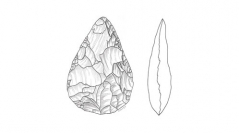

 Comptes Rendus Palevol
5 (1-2) - Pages 127-135
Comptes Rendus Palevol
5 (1-2) - Pages 127-135It is usually considered that artistic creativity is a trait of the modern human and that art appears only with Homo sapiens, at the beginning of the Upper Palaeolithic. If this fact seems well established, however it looks likely that the emergence of symbolic thought and aesthetic feeling has to be dated back to the Old Palaeolithic. Indeed, the Acheulean biface shows a morphological symmetry and a remarkable aesthetic. Whenever this tool exclusively constitutes the lithic assemblage of a culture, as it is the case in the site of Nadaouiyeh Aïn Askar (central Syria), it can be suggested that it represents a strong symbolic component. The question is, was this harmonic aspect of the form really conceived by the tool maker or does it result from an unconscious phenomenon related to the knapping of the artefact? If it is indeed a conscious and desired symmetry, it is not impossible that the artisan tried to project a part of him into the tool. Through this harmonic component of the bifaces, it seems that Homo erectus was already capable of symbolic behaviour and a kind of artistic creativity. It is not a question of art as traditional conception, but probably of its first steps.
Old Palaeolithic, Acheulean, Homo erectus, biface, art, symbolic thought